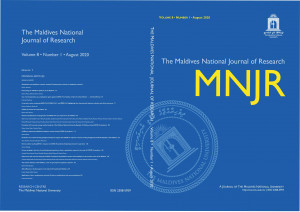Challenges in clinical learning: experiences of Maldivian nursing students
DOI:
https://doi.org/10.62338/ecnrpn81Keywords:
inclusive education, readiness, leadership, school climate, curriculum instruction, assessment, individual student support, knowledge, skills, teacher attitude, MaldivesAbstract
Clinical practice is an essential part of nursing education. It provides opportunity to apply theoretical knowledge, and develop skills. Nursing faculty need to identify ways to improve clinical learning for students. The aim of this paper was to obtain an understanding of experiences of clinical learning environment for Maldivian nursing students. A qualitative descriptive design was used and informed consent was obtained from all students. Data was collected from 20 students of Maldives National University, using four focus group discussions. Focus group interviews that lasted approximately one hour were conducted. The interviews were audio taped and transcribed verbatim. The transcripts were red multiple times to gain an understanding of students experiences. Discussions that related to students clinical experiences were extracted and coded under different themes. Mentors, clinical learning opportunities, clinical evaluation, and student feelings were found to be important components of clinical learning. Interpersonal relationships and communication with mentors were found to be important for motivation of students. Factors in the CLE enabled students to make good use of learning opportunities while other factors hindered their learning. Students felt that clinical evaluation was unfair and not reflective of their achievements. Students experienced a number of positive and negative feelings due to their experiences in the CLE. A number of factors present in the CLE could prevent it from becoming an effective learning environment for student nurses. It is important that nurse educators identify these and find ways to improve the effectiveness of the CLE.
References
Anarado, A. N., Agu, G. U. & Nwonu, E. I. (2016). Factors hindering clinical training of students in selected nursing educational institutions in Southeastern Nigeria. Nurse Education Today, 40, 140–145
Andrews, M. & Roberts, D. (2003). Supporting student nurses learning in and through clinical practice: The role of clinical guide. Nurse Education Today, 23, 474-481.
Awuah-Peasah, D, Sarfo, L. A. & Asamoah, F. (2013). The attitudes of student nurses toward clinical work. International Journal of Nursing and Midwifery, 5(2), 22-27. Available online http://www. Academicjouranals.org/ijnm.
Bisholt, B., Ohlsson, U., Engtrom, A. K., Johansson, A. S. & Gustafsson, M. (2014). Nursing students’ assessment of the learning environment in different clinical settings. Nurse Education in Practice, 14, 304-310.
Bradbury-Jones, C., Sambrook, S. & Irvine, F. (2011). Empowerment and being valued: A phenomenological study of nursing students’ experiences of clinical practice. Nurse Education Today, 31 (4), 368–372.
Brown, J. Stevens, J. & Kermode, S. (2012).Supporting student nurse professionalisation: The role of the clinical teacher. Nurse Education Today 3(5), 606-610.
Chesser-Smyth, P. A. (2005). The lived experiences of general student nurses on their clinical placement: A phenomenological study. Nurse Education in Practice, 5(6), 320-327.
Cooper, J., Courtney-Pratt, H., & Fitzgerald, M. (2015). Key influences identified by first year undergraduate nursing students as impacting on the quality of clinical placement: a qualitative study. Nurse Education Today 35(2015), 1004-1008.
Cordeau, M. A. (2010). The Lived Experience of Clinical Simulation of Novice Nursing Students. International Journal for Human Caring, 14(2), 9-15.
Courtney-Pratt H., Fitzgerald M., Ford K., Marsden K. & Marlow A. (2012) Quality Clinical Placements for Undergraduate Nursing Students: A Cross sectional Survey of Undergraduates And Supervising Nurses. Journal of Advanced Nursing 68(6), 1380–1390.
Coyne, E. & Needham, J. (2012). Undergraduate nursing students’ placement in specialty clinical areas: Understanding the concerns of the student and D’Souza, M. S., Karkada, S.N., Parahoo, K. & Venkatesaperumal, R. (2015).
Perception of and satisfaction with the clinical learning environment among nursing students. Nurse Education Today, 35, 833–840.
Foster, H., Ooms, A. & Marks-Maran, D. (2015). Nursing students’ expectation and experiences of mentorship. Nurse Education, Today, 35, 18-24.
Fotheringham, D., Lamont, D., Macbride, T., & MacKenzie, L. (2015). Linking theory to practice in introductory practice learning Experiences. Nurse Education in Practice, 15(2), 97-102.
Gallagher, O, Saunders, R., Tambree, K., Alliex, S., Monterosso, L. & Naglazas, Y. (2014). Nursing student experiences of death and dying during a palliative care clinical placement: teaching and learning implications. In Transformative, innovative and engaging. Proceedings of the 23rd Annual Teaching Learning Forum, 30-31 January 2014. Perth: The University of Western Australia. Available http://ctl.curtin.edu.au/professional_development/conferences/tlf/tlf2014/refereed/gallagher.pdf
Ha, E. (2015). Attitudes toward clinical practice in undergraduate nursing students: A Q methodology study. Nurse Education Today, 35, 733–739.Hegenbarth, M., Rawe, S. , Murray, L., Arnaet, A.& Chambers-Evans, J. (2015). Establishing and maintaining the clinical environment for nursing student: A Qualitative Study, Nurse Education Today, 35, 304-309.
Jonsén, E. Melender, H. & Hilli, Y (2013). Finnish and Swedish nursing students’ experiences of their first clinical practice placement - A qualitative study. Nurse Education Today, 33, 297–302.
Levett-Jones, T. & Lathlean, J. (2008). Belongingness: a prerequisite for nursing students’ clinical learning. Nurse education in Practice, 8(2), 103-110.
Lundberg, P. C & Boonprasabhai, K. (2001). Meanings of good nursing care among Thai female last-year undergraduate nursing students. Journal of Advanced Nursing, 34(1), 35-42.
Matchim, Y. & Kongsuwan, W. (2015). Thai nursing students’ experiences when attending real life situations involving cardiac life support: A Phenomenological study. Nurse Education Today, 35, 1186–1191
Mattila , L. Pitkäjärvi , M. & Eriksson, E. (2010). International student nurses’ experiences of clinical practice in the Finnish health care system. Nurse education in Practice, 10(3), 153-157.
McCallum, J. Lamont, D. & Kerr, E. (2016). First year undergraduate nursing students and nursing mentors: An evaluation of their experience of specialist areas as their hub practice learning environment. Nurse Education in Practice, 16, 182-187.
Melincavage, S. M. (2011). Student nurses’ experiences of anxiety in the clinical setting. Nurse Education Today 31, 785–789.
Meyer, R., Van Schalkwyk, S. C. & Prakaschandra, R. (2016). The operating room as a clinical learning environment: An exploratory study. Nurse Education in Practice, 18, 60-72.
Moonaghi, H. K., Mirhaghi, A., Oladi, S. & Zeydi, A. E. (2015). A journey across an unwelcoming field: A qualitative study exploring the factors influencing nursing student’s clinical education. Health Science Journal, 9 (4:4), 1-7



